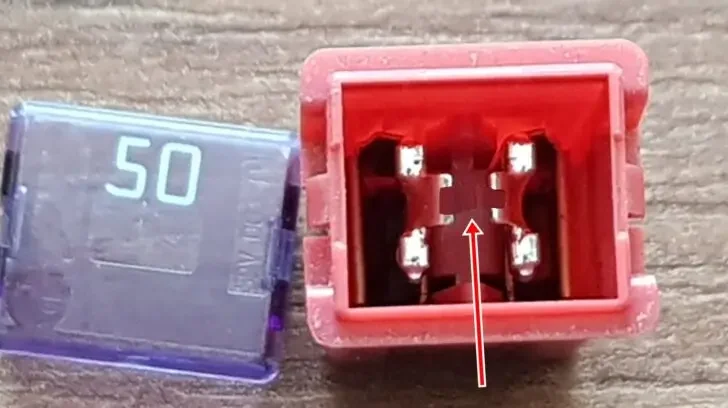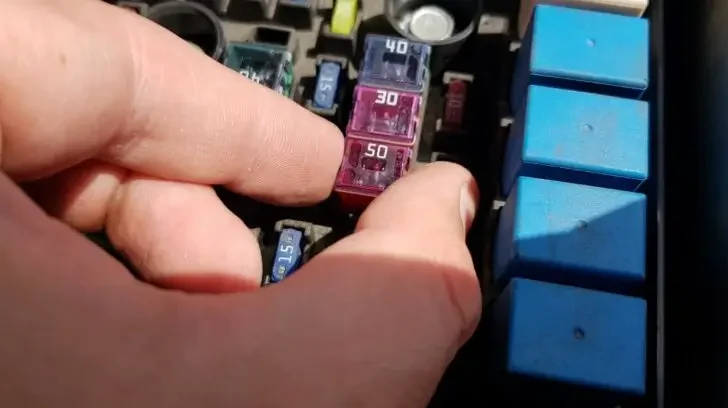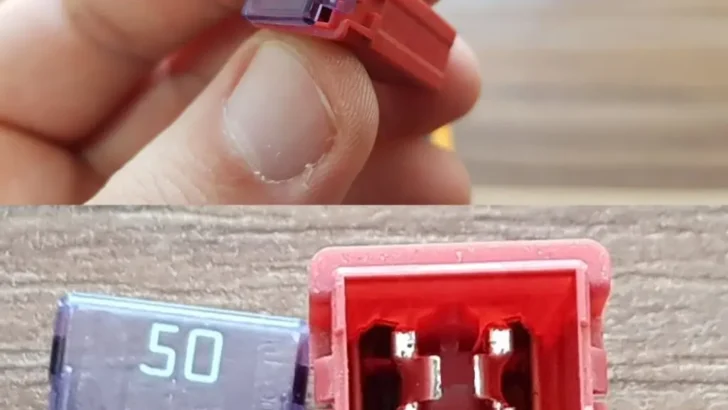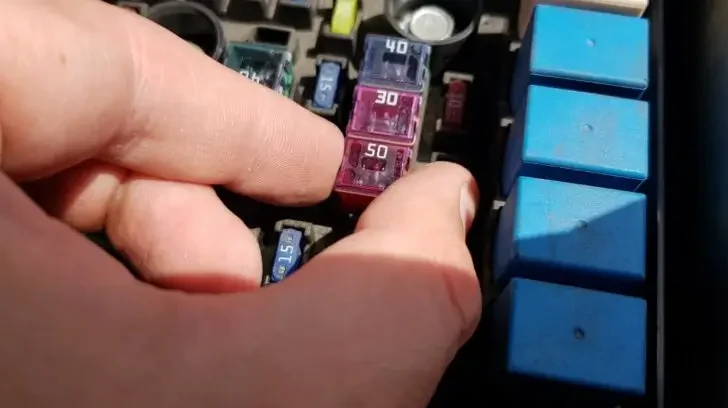Car fuses do not have an expected lifespan, meaning they can melt at any time. Most car owners experience a blown 50 amp fuse if they drive their vehicle for an extended period of time.
This occurs when the main component malfunctions and requests more current than it can handle, leading to the 50 amp fuse acting as a shield and blowing instead. But what exactly looks like when your 50 amp fuse has been blown?
In this blog post, I am going to talk about what 50 amp fuses are used in cars, what does a blown 50 amp fuse look like, and how to replace a blown 50 amp fuse.
Key Takeaway
- You can tell that a 50 amp fuse is blown if you visually inspect it. The fuse wire that is supposed to allow current to flow through it will appear melted/broken.
- A 50 amp fuse in a car is typically used to protect high-load electrical systems like the radiator fan, ignition, fuel pump, or audio system from excessive current that could cause damage or a fire.
What Is 50 Amp Fuse Used For In Cars

A 50 amp fuse is commonly used in cars to power several circuits, such as an engine running without lights that draw 50 amps; or it can serve as the main fuse which supplies multiple circuits and usually labels itself B+(battery positive).
Basically, any part of your vehicle that requires 50 amps to function correctly will be powered by this type of fuse.
Fuses have been around since 1967, protecting cables, wires, and electrical components of modern vehicles. Functioning like a shield fuses act as an effective defense when an electronic component starts drawing more power from its battery than it can handle – which is exactly why they’re necessary!
For instance, if an electrical component that is protected by a 50 amp fuse draws more current than this level, it will go from the battery and into the fuse.
However, if it is higher still, it could cause the 50 amp fuse to melt and create an open circuit – meaning the high current will stop at this stage instead of continuing onto the main component and burning it.
Vehicles typically have multiple 50 amp fuses to protect various electrical circuits. When the car idles without accessories connected, these fuses draw 50 amps of power.
On some models, this fuse may be labeled “B+,” meaning it serves as the main fuse that supplies multiple circuits simultaneously.
A single 50 amp fuse can supply electrical energy to multiple components simultaneously.
What Does a Blown 50 Amp Fuse Look Like

A blown 50 amp fuse typically appears with a disconnected or broken metal alloy strip (which often looks like a bridge) in the middle, and may have burnt or melted areas indicating excessive current flow.
A 50 amp fuse has a fuse wire running from one copper conductor to another. This acts as a bridge between the conductors, allowing current to pass through it and into its main component.
However, when this fuse blows due to an electrical overload, its appearance may differ significantly from a brand-new fuse.
When the 50 amp fuse blows, no electrical current can pass through it. This indicates that the main component being fed by this fuse required a higher voltage than it could handle and, when current flowed from the battery and into the fuse wire, it automatically melted the wire.
As designed, 50 amp fuses act as failsafe switches, melting before the high current reaches their intended target.
If you suspect one of the 50 amp fuses has blown, visually inspect it. Since these fuses come with cartridge casings, it may be difficult to inspect them visually; thus, remove the top lid and take a look inside.
A properly working 50 amp fuse will have a fuse wire (metal alloy strip) running from one copper conductor to another; if the fuse wire has melted/broken, replacement of this blown 50 amp fuse is necessary.
How To Replace a Blown 50 Amp Fuse
- Order a new 50 amp fuse.
- Open the hood and locate the fuse box.
- Open the fuse box and locate the blown 50 amp fuse.
- Remove the blown 50 amp fuse.
- Visually inspect the 50 amp fuse to verify that it is blown.
- Install the new 50 amp fuse.
- Close the fuse box and the hood.
Fuses are designed to melt in order to protect the main component from being burnt. This means that they are destined to fail often. But do not worry.
Replacing a blown 50 amp fuse is not as hard as people think. I will guide you through the process. So, without any further delay, here is how to replace a blown 50 amp fuse.
1. Order a new 50 amp fuse

When replacing a blown 50 amp fuse, it is important that you have a brand new 50 amp fuse on hand. Please do not use any old fuses because it is simply not worth it. A new 50 amp cartridge-style fuse costs around $1.30 but can save you a lot of money in the long term.
So, you can either order a new 50 amp fuse on amazon.com or go to your local part store. Whatever you decide to do, just make sure that you get the exact same fuse as your old one. A 50 amp fuse can be both blade-style or cartridge-style.
2. Open the hood and locate the fuse box

Locating the fuse box can be difficult if you are a young DIY mechanic. Pull the latch underneath your steering wheel to open the hood.
Then, as you stand in front of the engine, concentrate on the right side of the engine bay. You will notice a box that most of the time will be labeled as a fuse and relay box. That is what we are looking for.
3. Open the fuse box and locate the blown 50 amp fuse

The fuse box is usually secured by either a tab or a bolt. So, press on the tab or remove the bolt and open the fuse box. Underneath the fuse box lid, you will see a diagram of what each fuse is used for. Locate the blown 50 amp fuse with the help of the diagram.
Usually, there are two or three cartridge-style 50 amp fuses and a couple of blade-style 50 amp fuses. Take your time locating the blown 50 amp fuse.
4. Remove the blown 50 amp fuse

Once you locate the blown 50 amp fuse, it is time to remove it. First, try to remove the fuse with your hands. However, if the fuse is stuck, you can use pliers. When removing a blown 50 amp fuse, make sure that you don’t wiggle it around because you can damage the ports. It is important that you just pull it upwards in a straight line.
A note of caution. Some fuses just blew and do not do any damage to the container. However, a 50 amp fuse can sometimes melt, depending on how much current went through it. So, if the 50 amp fuse is melted, disconnect the battery and proceed with caution. Use gloves and pliers to remove the melted parts.
5. Visually inspect the blown 50 amp fuse

Just to be sure if you pulled out the correct blown 50 amp fuse, you will need to visually inspect it and then test it with a multimeter. Because the 50 amp fuse is in a cartridge, you will need to remove the lid. To do so, you will need to press the clips on each side with a toothpick or a needle and pull the lid off.
Once the lid is removed, you can visually inspect the 50 amp fuse. If the 50 amp fuse is blown, you will notice it right away. There is a metal alloy strip running from one side of the fuse to the other.
It kind of looks like a bridge. If the ”bridge” is disconnected in the middle, it means that the 50 amp fuse is blown. However, sometimes is not this simple to diagnose a blown fuse because the fuse wire can break on a hard-to-see spot. This is why I always check it with a multimeter.
6. Test the blown 50 amp fuse with a multimeter

As I said before, some fuse wires can break in a hard-to-see place. This is why it is important to test the fuse with a multimeter. Get a multimeter and set it on ohms. Before you perform the test, touch both ends of the multimeter and remember the reading.
Then, get the 50 amp fuse and insert the red and black wires from the multimeter into the fuse ports located on the backside.
If you get the same reading as you did when you only touched the wires from the multimeter, it means that the fuse is working correctly.
However, if you get a different reading, it means that the fuse is blown. So, if you touch the wires and you get 1 ohm, and then you test the fuse and you get 0 ohms, it means that the fuse is blown.
7. Install the new 50 amp fuse

Before you install the new 50 amp fuse, make sure that the fuse port is clean. If there is any debris left there, it can cause the fuse to blow out immediately. Then, simply insert the new 50 amp fuse all the way down. Close the fuse box by pressing it until you hear a click. That’s it.
Signs of a Blown 50 Amp Fuse
- No Power: The electrical system or device protected by the fuse is not working.
- Warning Lights: Some vehicles may display a warning light on the dashboard.
- Repeated Fuse Failure: If the same 50 amp fuse keeps blowing, it indicates a larger problem.
- Burnt Smell or Smoke: A blown fuse can sometimes cause a burnt smell or smoke.
- Visible Damage: On inspection, the fuse may show signs of damage like a broken wire or discoloration.
Causes of a Blown 50 Amp Fuse
- Overloading: The electrical system or device draws more current than the fuse can handle.
- Short Circuit: A direct connection between the positive and negative terminals, causing an excessive current flow.
- Aging: Older fuses may blow due to wear and tear over time.
- Poor Quality Fuse: Low-grade fuses may not withstand the rated current.
- Electrical Surges: Sudden spikes in electricity can cause a fuse to blow.
- Incorrect Fuse Rating: If the fuse is not suited for the electrical system’s demands, it may blow.
How Much Is a 50 Amp Fuse
A blade-style 50 amp fuse costs around $3 and a cartridge-style fuse costs around $1.30 on amazon.com. However, you can go to your local part store and probably get it for the same price, but without paying for shipping.
FAQs
Q: How can I identify a blown fuse?
A: To check if a fuse is blown, you can visually inspect the fuse and look for any signs of damage or a broken wire. Alternatively, you can use a multimeter to test the continuity of the fuse.
Q: Can a blown fuse cause a power outage?
A: Yes, a blown fuse can cause a power outage. When a fuse blows, it interrupts the flow of electricity and disconnects the circuit, resulting in a loss of power to the connected device or system.
Q: Can a blown 50 amp fuse be replaced?
A: Yes, a blown 50 amp fuse can be replaced. It is important to replace it with a fuse of the same amperage rating to ensure proper circuit protection. Using a lower or higher amperage fuse can lead to other electrical issues or damage.
Q: Are all 50 amp fuses the same size?
A: No, 50 amp fuses can come in different physical sizes depending on the type and brand. It is essential to choose the correct size and type of fuse that is compatible with your electrical system.
Q: Can a blown fuse be the cause of electrical problems?
A: Yes, a blown fuse can be the cause of electrical problems. If a fuse repeatedly blows, it could indicate an underlying issue with the circuit or connected devices, such as an overload or short circuit.
Q: Are there any safety measures I should take when dealing with fuses?
A: Yes, when dealing with fuses, it is important to follow these safety measures:
1. Always turn off the power supply to the circuit before working with fuses.
2. Use insulated tools to handle fuses to prevent electrical shock.
3. Replace fuses with the same amperage rating to ensure proper circuit protection.
4. If you are unsure about handling fuses, it is recommended to consult a qualified electrician.
Q: Can a blown 50 amp fuse affect multiple circuits?
A: Yes, a blown 50 amp fuse can affect multiple circuits if those circuits are connected to the same electrical panel and share the same fuse. When the fuse blows, it cuts off power to all the circuits connected to it.
Q: Why does a 50 amp fuse blow?
A: A 50 amp fuse can blow due to various reasons, including:
1. Overloading of the circuit with too much electrical current.
2. Short circuit caused by a direct connection between the hot wire and neutral wire.
3. Faulty wiring or damaged electrical components.
4. Using a fuse with the wrong amperage rating.
In Conclusion
A blown 50 amp fuse will often have a visible discoloration on the surface of the metal. The wire inside may also be dark or brittle, and might not make contact with the terminals when touched.
It is important to always replace fuses with one of the same amperage ratings in order to ensure safety and prevent further damage to equipment.
